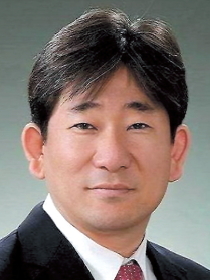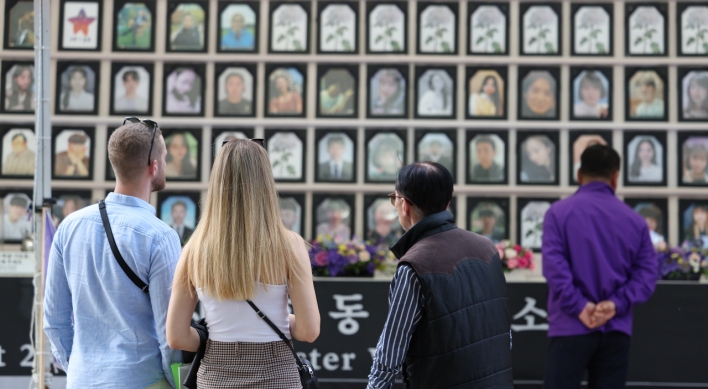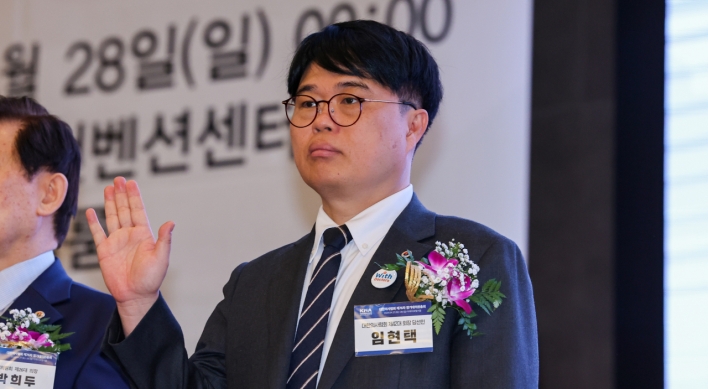We are celebrating the 60th anniversary of the Korea-U.S. alliance this year, making the summit meeting between presidents Park Geun-hye and Barack Obama this week even more meaningful.
Despite ups and downs in its evolution, the Korea-U.S. alliance has been valuable for the national interests of the U.S. and South Korea during the Cold War and since.
After the end of the Korean War, an armistice was signed on July 27, 1953, followed by the Mutual Defense Treaty on Oct. 1, 1953.
The Korea-U.S. alliance has been a bulwark to North Korean threats and the communist bloc ever since. Even though the Mutual Defense Treaty did not specify an expiration date, clarify the territories to be defended, clarify the definition of an armed attack, or specify how to deal with common dangers, the treaty provided a basis for continuing security cooperation between the two countries.
For example, when President Eisenhower visited South Korea, he felt the need to assist South Korea militarily, and the U.S. provided more than $3 million worth of equipment, supplies and services between 1953 and 1969.
When Park Chung-hee came to power, he expressed an adamant anticommunist ideology as his national policy and promised to develop economic self-sufficiency in South Korea. President John F. Kennedy promised him aid to enable him to undertake his five-year plan for economic development.
Of course, the Korea-U.S. alliance during the Cold War was not always solid. After defeat in the Vietnam War, President Nixon withdrew the U.S. 7th Infantry Division from South Korea, and under the Carter administration, the U.S. attempted to withdraw 3,400 U.S. ground troops. Notwithstanding, the alliance maintained consistent robustness during the Cold War with the two sharing strategic objectives: The U.S. sought to use the alliance to contain the communist bloc, and South Korea used it to cope with threats from North Korea.
When the Cold War ended, the two countries began to think differently about the validity of the alliance. The situation on the Korean Peninsula became only one of the U.S.’ security concerns.
For example, in the 1992 report to the Congress, “A Strategic Framework for the Asian Pacific Rim,” the U.S. defined one of its security objectives in South Korea as “transforming the U.S. forces on the peninsula from a leading to a supporting role, including some force reductions.” This has been realized with the transfer of peacetime operational control to the South Korean military in 1994. For the U.S., with the demise of the Soviet Union, the strategy of containing North Korea was not as significant as the Cold War period.
With the inauguration of Kim Dae-jung as president and his initiation of the “Sunshine Policy” toward the North, the Korea-U.S. alliance came into jeopardy. South Korea began to look at North Korea more as somewhere with the same national identity to be unified with, but the Bush administration’s perception of the North grew worse, treating it as a rogue state.
After the North-South Korean Summit on June 13, 2000, Kim Dae-jung announced that the possibility of war on the Korean Peninsula no longer existed. During this time, the South Koreans began to think of North Korea differently, and this change in perception significantly affected the cohesiveness of the Korea-U.S. alliance, which continued throughout the Roh Moo-hyun government.
Now where do we stand? The Korea-U.S. alliance was restored and reinforced during the Lee Myung-bak government. In 2009, President Lee and had a summit meeting with U.S. President Barack Obama, in which they announced a joint vision and renewed the alliance into “comprehensive strategic alliance.”
The two leaders broadened the cooperation that was previously centered on the Korean Peninsula to the Asian and global area, with the scope of cooperation encompassing not only security but also other areas.
The two countries also made mutual consents. In security, the alliance reinforced a strong defense posture through the continuing commitment of extended deterrence, including the U.S. nuclear umbrella, and promoted advancement of the “Korea leading-U.S. supporting” security relationship through the continued restructuring of the alliance.
That is, the U.S. has made a security commitment through the U.S. military stationed on the Korean Peninsula, and stipulated its commitment to extended deterrence, including inclusion of coverage under the U.S. nuclear umbrella.
This agreement was first of its kind between the two leaders to reaffirm in writing the U.S.’ strong pledge of defense of the region. After military provocations by North Korea in 2010, the two countries agreed to create the Extended Deterrence Policy Committee to discuss U.S. measures to provide security to South Korea.
With President Park Geun-hye coming to power, the Korea-U.S. alliance maintains robustness but at the same time possesses challenges and tasks.
First, the two countries need to institutionalize the comprehensive strategic alliance. That is, South Korea and the U.S. should make a road map for the alliance. In the alliance road map, two countries should determine common strategic objectives and common threats of the alliance.
When the vision and rationale of the alliance is set up, then they should discuss operational guidelines of the military forces, meaning roles, missions and capabilities. They should work out specific operational guidelines regarding how to construct military command and control in preparation for the transfer of wartime operational control scheduled in 2015. This road map should be drawn up in the “two plus two” meeting.
Second, the two countries should seek fundamental solutions to deal with North Korea’s nuclear program. Currently, the U.S. is maintaining “strategic patience” toward the North, signifying that the U.S. would not have a meaningless dialogue with the North if it does not behave sincerely in dismantling its nuclear program.
However, this policy cannot be sustained in the long term: If North Korea continues to develop its nuclear program to the level by which it can be a direct threat to the U.S., the U.S. will have no option but to talk with the North. So, the two countries need to ponder a more fundamental North Korea policy, while preparing strong deterrence measures for North Korean threats.
Third, there are also important issues to be solved. They have to prepare for the period after transfer of wartime operational control, in which the South Korean military should take the initiative within the combined military command structure. They also have to continue to revise the Korea-U.S. Atomic Energy Agreement, and have to begin negotiations for the next-term Special Measures Agreement.
The Korea-U.S. alliance is in the middle of a transformation and reinforcement. The two countries are transforming the alliance into a new 21st century mechanism. For this purpose, the alliance should have its new role and rationale defined. I hope the upcoming Park-Obama summit meeting will bring about a new momentum for the rebirth of the Korea-U.S. alliance and maximize the common needs and interests of the two allies.
Despite ups and downs in its evolution, the Korea-U.S. alliance has been valuable for the national interests of the U.S. and South Korea during the Cold War and since.
After the end of the Korean War, an armistice was signed on July 27, 1953, followed by the Mutual Defense Treaty on Oct. 1, 1953.
The Korea-U.S. alliance has been a bulwark to North Korean threats and the communist bloc ever since. Even though the Mutual Defense Treaty did not specify an expiration date, clarify the territories to be defended, clarify the definition of an armed attack, or specify how to deal with common dangers, the treaty provided a basis for continuing security cooperation between the two countries.
For example, when President Eisenhower visited South Korea, he felt the need to assist South Korea militarily, and the U.S. provided more than $3 million worth of equipment, supplies and services between 1953 and 1969.
When Park Chung-hee came to power, he expressed an adamant anticommunist ideology as his national policy and promised to develop economic self-sufficiency in South Korea. President John F. Kennedy promised him aid to enable him to undertake his five-year plan for economic development.
Of course, the Korea-U.S. alliance during the Cold War was not always solid. After defeat in the Vietnam War, President Nixon withdrew the U.S. 7th Infantry Division from South Korea, and under the Carter administration, the U.S. attempted to withdraw 3,400 U.S. ground troops. Notwithstanding, the alliance maintained consistent robustness during the Cold War with the two sharing strategic objectives: The U.S. sought to use the alliance to contain the communist bloc, and South Korea used it to cope with threats from North Korea.
When the Cold War ended, the two countries began to think differently about the validity of the alliance. The situation on the Korean Peninsula became only one of the U.S.’ security concerns.
For example, in the 1992 report to the Congress, “A Strategic Framework for the Asian Pacific Rim,” the U.S. defined one of its security objectives in South Korea as “transforming the U.S. forces on the peninsula from a leading to a supporting role, including some force reductions.” This has been realized with the transfer of peacetime operational control to the South Korean military in 1994. For the U.S., with the demise of the Soviet Union, the strategy of containing North Korea was not as significant as the Cold War period.
With the inauguration of Kim Dae-jung as president and his initiation of the “Sunshine Policy” toward the North, the Korea-U.S. alliance came into jeopardy. South Korea began to look at North Korea more as somewhere with the same national identity to be unified with, but the Bush administration’s perception of the North grew worse, treating it as a rogue state.
After the North-South Korean Summit on June 13, 2000, Kim Dae-jung announced that the possibility of war on the Korean Peninsula no longer existed. During this time, the South Koreans began to think of North Korea differently, and this change in perception significantly affected the cohesiveness of the Korea-U.S. alliance, which continued throughout the Roh Moo-hyun government.
Now where do we stand? The Korea-U.S. alliance was restored and reinforced during the Lee Myung-bak government. In 2009, President Lee and had a summit meeting with U.S. President Barack Obama, in which they announced a joint vision and renewed the alliance into “comprehensive strategic alliance.”
The two leaders broadened the cooperation that was previously centered on the Korean Peninsula to the Asian and global area, with the scope of cooperation encompassing not only security but also other areas.
The two countries also made mutual consents. In security, the alliance reinforced a strong defense posture through the continuing commitment of extended deterrence, including the U.S. nuclear umbrella, and promoted advancement of the “Korea leading-U.S. supporting” security relationship through the continued restructuring of the alliance.
That is, the U.S. has made a security commitment through the U.S. military stationed on the Korean Peninsula, and stipulated its commitment to extended deterrence, including inclusion of coverage under the U.S. nuclear umbrella.
This agreement was first of its kind between the two leaders to reaffirm in writing the U.S.’ strong pledge of defense of the region. After military provocations by North Korea in 2010, the two countries agreed to create the Extended Deterrence Policy Committee to discuss U.S. measures to provide security to South Korea.
With President Park Geun-hye coming to power, the Korea-U.S. alliance maintains robustness but at the same time possesses challenges and tasks.
First, the two countries need to institutionalize the comprehensive strategic alliance. That is, South Korea and the U.S. should make a road map for the alliance. In the alliance road map, two countries should determine common strategic objectives and common threats of the alliance.
When the vision and rationale of the alliance is set up, then they should discuss operational guidelines of the military forces, meaning roles, missions and capabilities. They should work out specific operational guidelines regarding how to construct military command and control in preparation for the transfer of wartime operational control scheduled in 2015. This road map should be drawn up in the “two plus two” meeting.
Second, the two countries should seek fundamental solutions to deal with North Korea’s nuclear program. Currently, the U.S. is maintaining “strategic patience” toward the North, signifying that the U.S. would not have a meaningless dialogue with the North if it does not behave sincerely in dismantling its nuclear program.
However, this policy cannot be sustained in the long term: If North Korea continues to develop its nuclear program to the level by which it can be a direct threat to the U.S., the U.S. will have no option but to talk with the North. So, the two countries need to ponder a more fundamental North Korea policy, while preparing strong deterrence measures for North Korean threats.
Third, there are also important issues to be solved. They have to prepare for the period after transfer of wartime operational control, in which the South Korean military should take the initiative within the combined military command structure. They also have to continue to revise the Korea-U.S. Atomic Energy Agreement, and have to begin negotiations for the next-term Special Measures Agreement.
The Korea-U.S. alliance is in the middle of a transformation and reinforcement. The two countries are transforming the alliance into a new 21st century mechanism. For this purpose, the alliance should have its new role and rationale defined. I hope the upcoming Park-Obama summit meeting will bring about a new momentum for the rebirth of the Korea-U.S. alliance and maximize the common needs and interests of the two allies.

By Kim Hyun-wook
Kim Hyun-wook
● Professor Kim Hyun-wook is currently director-general at the Department of American Studies, Korea National Diplomatic Academy.
● His research areas include the Korea-U.S. alliance, U.S.-North Korea relations, and East Asian security.
● He received a Ph.D. in political science from Brown University, and worked as a postdoctoral fellow at the University of Southern California.
-
Articles by Korea Herald







![[Music in drama] Rekindle a love that slipped through your fingers](http://res.heraldm.com/phpwas/restmb_idxmake.php?idx=644&simg=/content/image/2024/05/01/20240501050484_0.jpg&u=20240501151646)


![[New faces of Assembly] Architect behind ‘audacious initiative’ believes in denuclearized North Korea](http://res.heraldm.com/phpwas/restmb_idxmake.php?idx=644&simg=/content/image/2024/05/01/20240501050627_0.jpg&u=20240502093000)








